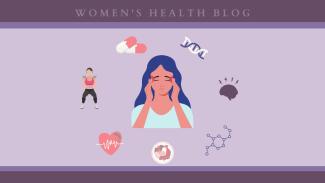Author: Negin Nia, B.A. & M.J.,University of British Columbia. Editors: Romina Garcia de leon & Shayda Swann (Blog Co-coordinators).
Published: June 23, 2023
Living with migraines means every day is uncertain. When my first migraine attack happened, I experienced intense pain and went to the hospital as a precaution. The doctor said my symptoms were normal migraine signs.
Migraines, which are described as a neurological disorder, are a common health condition, especially for women. But, it can be hard to distinguish them from a regular headache as they are easily misunderstood or dismissed. That’s why for migraine awareness month, we want to help educate others on migraines.
Defining a migraine attack
Migraine attacks are a moderate to severe intense pain on one side of the head. A migraine can manifest differently for each person – some have mild impairments, others may require medical attention.
Migraines can result from a combination of genetic, environmental, and lifestyle factors which make the brain vulnerable to specific stimuli and trigger an attack. Common triggers include stress, lack of sleep, alcohol, diet, and more.
Migraines are the world’s third most common ailment and the leading cause of disability in those aged 15 to 49. Migraines are more common in females than males — one in every five females have migraines compared to one in every 15 males.
This overrepresentation is initially seen after the onset of puberty, suggesting the role of sex hormones. There is also evidence that menstruation is a time of increased risk for migraine attacks, and a subset of people (approximately 10-20%) report migraines exclusively during menstruation.
Researchers suggest that fluctuations in hormones such as estrogens and progesterone have an impact. This is why for many people, migraines may lessen or worsen during pregnancy and menopause, with the use of hormonal contraceptives or hormone replacement therapy.
The symptoms and stages
In most patients, there are four migraine stages. The first is prodrome, which is the pre-headache. Symptoms may include fatigue, yawning, insomnia, food cravings, anxiety, depression, and more. You can catch a migraine at this stage but it is often hard to distinguish it from other issues.
The next stage is aura, which is associated with sensory disturbances such as loss of sight, blind spots, and flashes. It is also common to feel nauseous or sensitive to light and sound. Auras are not experienced by all – only one-third of migraine patients experience them. Females are more likely to experience these factors compared to males.
The third stage is the throbbing one-sided headache. Although the exact neural underpinnings remain unknown, there are some theories. The neurovascular theory explains that this pain is due to the activation of the trigeminal-nociceptive pathway and the inflammation that follows. Some work seems to link the role of serotonin in activating this pathway. Interestingly,
Raising Awareness
There is a clear lack of public information surrounding migraines. Migraines are an invisible disability that requires more attention and care. There is also a shared feeling of shame and stigma amongst migraine patients when being downplayed for just having a “headache.”
Given this, it is important to raise more awareness and set up proper support systems for migraine patients. By talking more about this neurological disorder, we can break stigmas and help create an environment of empathy.
